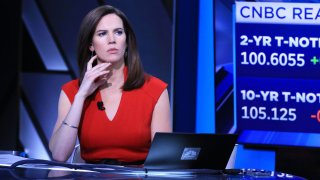
Kelly Evans
At first glance, the data this morning seem to be saying the U.S. economy is doing just fine, thank you. Jobless claims got even better last week! New durable goods orders were way above expectations! GDP came in at a healthy 2.9% last quarter!
"Really not sure why anyone thinks the economy is weak or even slowing," said one commentator.
So let's unpack this. Two of the data points--jobless claims and durable goods orders--are leading indicators. GDP is lagging. Jobless claims being this strong tell us payrolls probably didn't shrink yet in January, pushing off the recession arrival by possibly a couple of months. But it may also keep the Fed from doing a smaller rate hike or even a pause next week, which is not so good.
New durable goods orders, unfortunately, were less than met the eye. The 5% monthly pop was all on new Boeing plane orders. The "core" new orders gauge dropped in December, reflecting broader weakness. U.S. manufacturing actually peaked last April, and industrial production overall--one of the six monthly metrics used to date recessions--peaked in September.
Get Philly local news, weather forecasts, sports and entertainment stories to your inbox. Sign up for NBC Philadelphia newsletters.
As for the other five recession indicators that the official committee uses, two are consumer spending proxies, two are employment gauges, and one is an income metric. It's worth noting that the recession tends to show up last in these readings, especially the employment and income data. Manufacturing, by contrast, tends to slow first. I actually have a white paper coming out this week on how to tell when we're in recession--I will definitely link to it.
People lately are all "hey, inflation is down and the labor market is still strong, so the consumer is finally coming out ahead!" But I'm like, you should look at the "real personal income" series, and it's not so reassuring. This is the income proxy the recession daters use; "real personal income less government transfers." Check it out here; it actually peaked in November of 2021.
So at least two of the key data points suggest the economy has already been rolling over. What about consumer spending? "Real" personal consumption expenditures flatlined from October to November. The GDP data this morning suggests it eked out a 2.1% annualized gain for the last quarter as a whole, a far cry from the 2.9% that was expected. So even if spending was better outside of the terrible "retail sales" report we got for December, it's not exactly going gangbusters everywhere else.
Money Report
The other spending proxy officials use is "wholesale retail sales" in real terms, or adjusted for price changes. It's the only of the six metrics I can't easily find on the St. Louis FRED database (unless I'm missing something). But given the trend in overall retail sales and consumer spending more broadly in recent months, I think we can safely infer this isn't a huge area of strength right now.
That leaves only the labor market data. Payrolls are still expanding; once that stops, the recession is definitely here. The outright level of household employment is still rising, to 159 million in December; only as of September did we actually surpass the level we were at in February of 2020, before Covid hit. But basically, if you want to make the case for us avoiding a recession this year, you need to expect this level can continue to rise and fuel gains in all of the aforementioned economic categories.
The bond market, unfortunately, is betting that employment can't keep bucking the trend, and that it will ultimately succomb to the slowing that seems to be setting in economy-wide. If the Fed were slamming the brakes here on rate hikes, we could all hope the curves would uninvert and maybe the economy could avoid a recession. But they still appear dead-set on this tightening course until the last of the data give out.
See you at 1 p.m!
Kelly